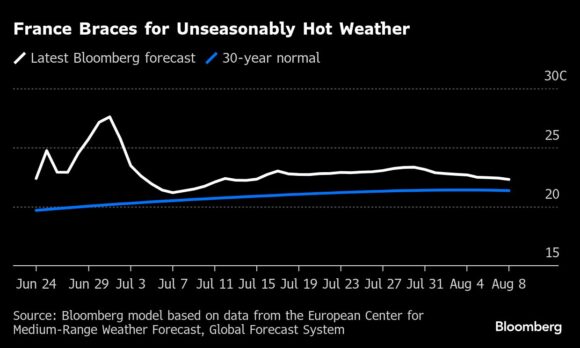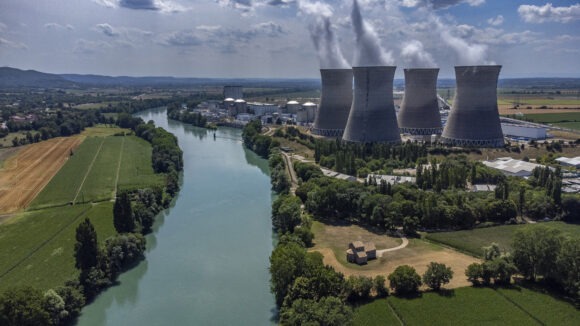Europe’s heat wave is intensifying, fueling wildfires across the Mediterranean and threatening to curb electricity generation from both nuclear and hydropower plants.
Temperatures in Spain are forecast to hit 39C (102F) on Wednesday, but could climb further to 42C next week as hot air streams in from North Africa, according to Rubén del Campo, a spokesperson for Spanish forecaster Aemet.
Heat alerts have been issued across southern regions, including more than half of France, with water sprays and fans being distributed to cool students in Marseille schools. That could also hit several of Electricite de France SA’s reactors along the Garonne and Rhone rivers as rising water temperatures compromise cooling operations.
Read more: Wildfire Alerts Issued Across Mediterranean as Heat Wave Builds
Global warming is boosting the intensity and frequency of heat waves, disrupting power grids just as demand for summer cooling increases. At the same time, the heat is generating violent storms, which on Wednesday shut roads and cut power to 8,000 customers in France’s Bassin d’Arcachon region.
While firefighters on the Greek island of Chios brought a number of blazes under control, wildfire warnings were issued for central and southern France.
The next blast of heat — peaking at the end of next week — could bring even hotter conditions, according to data from Atmospheric G2 and analysis from weather analytics firm MetDesk.
Europe’s power markets remain sensitive to any issues affecting the French nuclear fleet, the region’s largest. Interruptions to that supply could push countries to increase their reliance on fossil fuels.
France’s day-ahead power price surged to €81.8 per megawatt-hour, the highest level since March. Prices for July climbed as much as 8.3%. Nuclear output may be restricted at EDF’s Blayais site from June 30, St. Alban from July 1, and Golfech from July 2.
“The river temperatures of the Garonne and Rhone are very likely to lead to production restrictions until next week,” said Nathalie Gerl, lead power analyst at LSEG. “In the case of the Garonne, we see a higher risk of this happening again this summer.”

From the end of June, temperatures in France are forecast to rise to the highest level since 2022, according to data from Atmospheric G2. This will drive up cooling degree days — a measure of air conditioning demand — to nearly double their current level by early July, according to Bloomberg models.
The heat potentially poses an even bigger threat to Europe’s hydropower output. Run-of-river hydro generation in France hit its lowest level in over a decade this week, with little sign of relief, according to data from Energy Aspects.
When combined with potential nuclear curtailments and surging cooling demand, that could further boost French and German power prices, said William Peck, Senior Power Analyst at Energy Aspects.
Photograph: The Bugey nuclear power station in France. Photo credit: Jose Cendon/Bloomberg
Was this article valuable?
Here are more articles you may enjoy.



 US E&S Outlook No Longer Positive: AM Best
US E&S Outlook No Longer Positive: AM Best  Truckers Who Fail English Tests Are Pulled Off Roads in Crackdown
Truckers Who Fail English Tests Are Pulled Off Roads in Crackdown  State Farm Sued Over Policies Backed by Distressed Insurer PHL
State Farm Sued Over Policies Backed by Distressed Insurer PHL  Owner of Historic Minnesota Resort Charged With Arson, Insurance Fraud
Owner of Historic Minnesota Resort Charged With Arson, Insurance Fraud 

